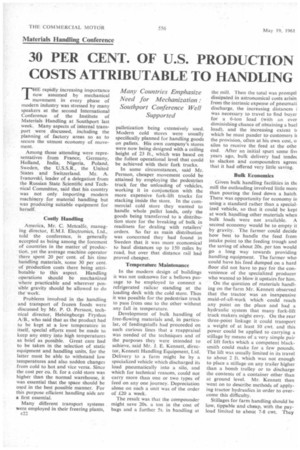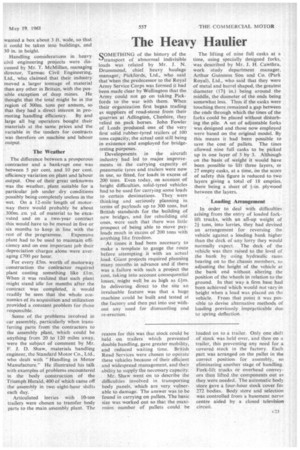Materials Handling Conference
Page 60

Page 61

If you've noticed an error in this article please click here to report it so we can fix it.
30 PER CENT. OF U.S. PRODUCTION COSTS ATTRIBUTABLE TO HANDLING
Many Countries Emphasize Need for Mechanization: Southport Conference. Well Supported THE rapidly increasing importance now assumed by mechanical movement in every phase of modern industry was stressed by many speakers at the second International Conference of the Institute of Materials Handling at Southport last week. Many aspects of internal transport were discussed, including the planning of factory areas so as to secure the utmost economy of movement.
Among those attending were representatives from France, Germany, Holland, India, Nigeria, Poland, Sweden, the U.S.S.R., the United States and Switzerland. Mr. A. Ivanovski, leader of a delegation from the Russian State Scientific and Technical Committee, said that his country was not only importing modern machinery for material handling but was producing suitable equipment for herself.
Costly Handling
America, Mr. C. Metcalfe, managing director, E.M.I. Electronics, Ltd., told the conference, is generally accepted as being among the foremost of countries in the matter of production, yet the average machine operator there spent 20 per cent. of his time handling materials, some 30 per cent. of production costs there being attributable to this aspect. Handling operations should be mechanized where practicable and wherever possible gravity should be allowed to do the work.
Problems involved in the handling and transport of frozen foods were discussed by Mr. P. 0. Persson, technical director, Helsingborgs Fryshus AIR, who said that as the product had to be kept at a low temperature in itself, special efforts must be made to keep any entry into high temperatures as brief as possible. Great care had to be taken in the selection of static equipment and handling units, for the latter must be able to withstand low temperatures and also sudden changes from cold to hot and vice versa. Since the cost per cu. ft. for a cold store was higher than the normal warehouse, it was essential that the space should be used in the best possible manner. For this purpose efficient handling aids arc a first essential.
Many different transport systems were employed in their freezing plants, c22 palletization being extensively used. Modern cold stores were usually specifically planned for handling goods on pallets. His own company's stores were now being designed with a ceiling height of 23 ft., which was based on the fullest operational level that could be achieved with their fork trucks.
In some circumstances, said Mr. Persson, cheaper movement could be attained by employing the pedestrian truck for the unloading of vehicles, working it in conjunction with the more expensive fork-lift trucks for stacking inside the store. In the commercial cold store they wanted to handle whole pallet loads, only the goods being transferred to a distribution store for the breaking of bulk in readiness for dealing with retailers' orders. So far as main distribution was concerned they had found in Sweden that it was more economical to haul distances up to 150 miles by road, but over that distance rail had proved cheaper.
Temperature Maintenance
In the modern design of buildings it was not unknown for a bellows passage to be employed to connect a refrigerated railcar standing at the loading deck with the cold store. Thus it was possible for the pedestrian truck to pass from one to the other without any fall in temperature.
Development of bulk handling of free-flowing materials and, in particular, of feedingstuffs had proceeded on such curious lines that a reappraisal was needed of the techniques and of the purposes they were intended to achieve, said Mr. J. E. Kennett, director, Kennett Handling Equipment, Ltd. Delivery to a farm might be by a specialized vehicle which discharged its load pneumatically into a silo, and which for technical reasons, could not carry more than one or two types of feed on any one journey. Depreciation alone on such a unit was of the order of £20 a week.
The result was that the compounder might save 20s. a ton in the cost of bags and a further 5s. in handling at the mill. Then the total was promptl dissipated in astronomical costs arisin from the intrinsic expense of pneumati discharge, the increasing distances i was necessary to travel to find buyer for a 6-ton load (with an ever diminishing chance of obtaining a bad] load), and the increasing extent ti which he must pander to customers ii the provision, often at his own cost, o silos to receive the feed at the othe end. After an initial spurt some fivi years ago, bulk delivery had tendet to slacken and compounders agree( that it had offered very little saving.
Bulk Economies
Given bulk handling facilities in tht mill the outloading involved little mon than pouring the feed down a hatch, There was opportunity for economy in using a standard rather than a specialized vehicle, so that it could be kept at work handling other materials when bulk loads were not available. A second economy would be to empty it by gravity. The farmer could decide how best to handle the feed from intake point to the feeding trough and the saving of about 20s. per ton would go a long way towards providing handling equipment. The farmer who could have his feed dumped on a hard floor did not have to pay for the convenience of the specialized producer who wanted to blow it upstairs for him.
On the question of materials handling on thelarm Mr. Kennett observed that the tractor was an inexpensive maid-of-all-work which could reach any point on the place and had a hydraulic system that many fork-lift truck makers might envy. On the rear three-point linkage it could transport a weight of at least 10 cwt. and this power could be applied to carrying a stillage by means of a very simple pair of lift forks which a competent blacksmith could make for a few pounds. The lift was usually limited in its travel to about 2 ft. which was not enough to place a stillage on any trailer higher than a bomb trolley or to discharge the contents of a container other than at ground level, Mr. Kennett then went on to describe methods of applying tractor hydraulics in order to overcome this difficulty, Stillages for farm handling should be low, tippable and cheap, with the payload limited to about 7-8 cwt. They wanted a box about 3 ft. wide, so that it could be taken into buildings, and 30 in. in height.
Handling considerations in heavy civil engineering projects were discussed by Mr. T. McMillan, managing director, Tarmac Civil Engineering, Ltd., who claimed that their industry moved a larger tonnage of material than any other in Britain, with the possible exception of deep mines. He thought that the total might be in the region of 300m. tons per annum, so that they had a direct interest in pro moting handling efficiency. By and large all big operators bought their materials at the same prices and the variable in the tenders for contracts was therefore on machine and labour output.
The Weather
The difference between a prosperous contractor and a bankrupt one was between 5 per cent. and 10 per cent. efficiency variation on plant and labour output. One of their great unknowns was the weather, plant suitable for a particular job under dry conditions possibly being completely useless in the wet. On a 12-mile length of motorway there would probably be about 300m. Cu. yd. of material to be excavated and on a two-year contract this would have to be moved in five or six months to keep in line with the rest of the programme. Expensive plant had to be used to maintain efficiency and on one important job their depreciation charges alone were averaging £700 per hour.
For every £5m. worth of motorway construction the con'tractor required plant costing something like £1m. When it was realized that such plant might stand idle for months after the contract was completed, it would readily be seen that the whole economics of its acquisition and utilization provided a constant problem for those responsible.
Some of the problems involved in car assembly, particularly when transferring parts from the contractors to the assembly plant, which could be anything from 20 to 120 miles away, were the subject of comment by Mr. F. J. D. Shaw, materials handling engineer, the Standard Motor Co., Ltd., who dealt with "Handling in Motor Manufacture." He illustrated his talk with examples of problems encountered in the body construction of the Triumph Herald, 400 of which came off the assembly in two eight-hour shifts each day.
Articulated lorries with 10-ton trailers were chosen to transfer body parts to the main assembly plant. The reason for this was that stock could be held on trailers which prevented double handling, gave greater mobility, and reduced waiting time. British Road Services were chosen to operate these vehicles because of their efficient and widespread management, and their ability to supply the necessary capacity.
Mr. Shaw went on to describe the difficulties involved in transporting body panels, which are very vulnerable to damage. The answer was to be found in carrying on pallets. The basic size was worked out so that the maximum number of pallets could be loaded on to a trailer. Only one shift of stock was held over, and then on a trailer, this preventing any need for a covered stock in the factory. Each part was arranged on the pallet in the correct position for assembly, so eliminating another stage of handling. Fork-lift trucks or overhead conveyors then lifted .the components out as they were needed. The automatic body store gave a four-hour stock cover for 272 bodies. Body store and selection was controlled from a basement nerve centre aided by a closed television circuit.




























































































































